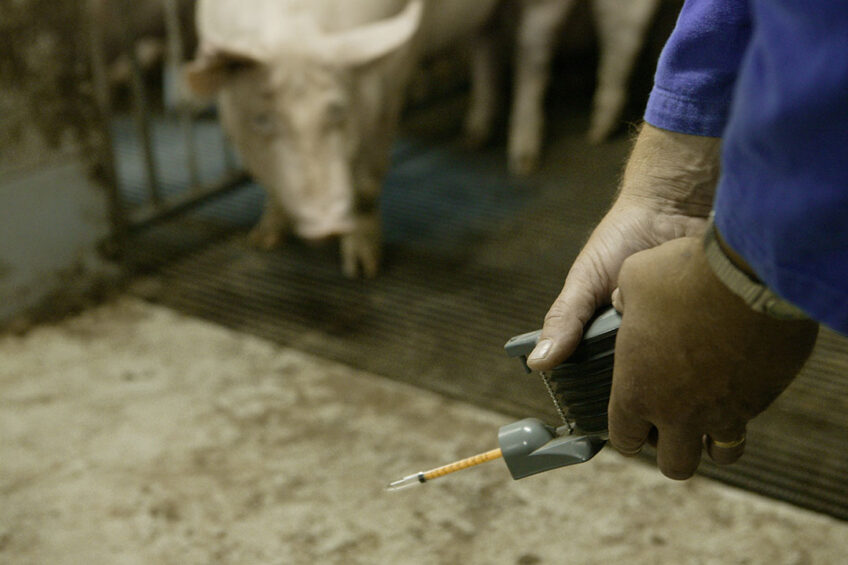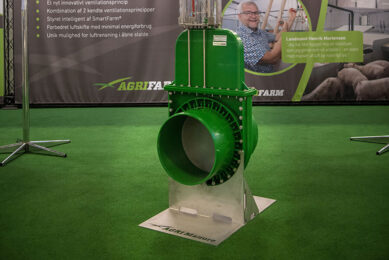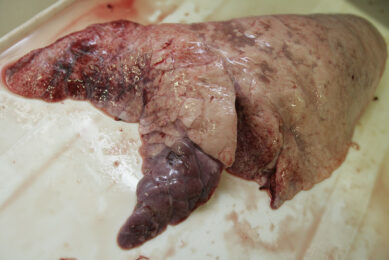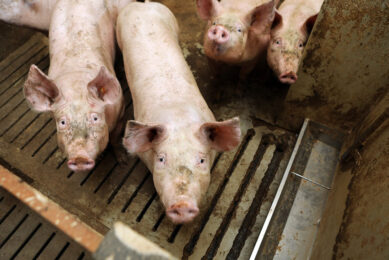Impact on pigs of chronic exposure to ammonia

A comparison is often made between pigs and Olympic sportspeople: they need to perform brilliantly during their 5 to 6 months in the barns. For that they need access to fresh air. Research has shown very clearly that pig houses full of pungent ammonia do not provide top notch accommodation for excellent performance.
Over the last few decades, swine production intensification has led to high concentrations of ammonia emissions from commercial swine farms across the globe. Ammonia is one of the major environmental pollutants produced by natural and several anthropogenic sources, with detrimental impacts on public health and on swine health, welfare and production performance. In addition, ammonia plays a significant role in development of atmospheric particulate matter, visibility degradation and atmospheric deposition of nitrogen to sensitive ecosystems. This in turn affects the environment and leads to climate change.
Therefore, it is important to have a clear understanding of ammonia sources, impacts and approaches to resolve this challenge. This article integrates the knowledge available on ammonia production through commercial swine farms, describes the health implications of ammonia emissions and explains effective control strategies to tackle this issue.
What is ammonia?
Ammonia is a major component of total reactive nitrogen. In addition, it is a soluble alkaline gas in the atmosphere, and can easily convert into fine particle ammonium aerosols. Ammonia is a colourless gas lighter than air. it has a sharp, pungent odour that people can smell at about 5–18 ppm. The breakdown and volatilisation of urea produce ammonia. It is soluble in water and turns into ammonium ion. 99% of it remains in the liquid form at low pH (<7, acidic conditions). At high pH (>7, basic conditions) some of the ammonium converts to gaseous ammonia and escapes when exposed to open air. When the pH is 9.25, 50% of ammonia is in gas and 50% is in liquid form.
What are the sources of ammonia?
Ammonia originates from both natural and anthropogenic sources. Anthropogenic sources, which are the largest source of ammonia emission, include agricultural activity, animal husbandry and waste. They also include ammonia-based fertiliser application, volatilisation of chemical fertilisers, biomass burning, catalytic converters in petrol cars, landfill sites, sewage works, composting of organic materials, combustion of fossil fuels and industrial processes.
Natural sources of ammonia emission include wild mammals and birds, volatilisation from soils and ocean and micro-organisms decomposing organic matter. Ammonia from anthropogenic sources has become a public concern due to its deleterious impacts on public health and the environment as well as on animal health, welfare and production performance.
Ammonia emissions from the swine industry
Pigs consume protein and other forms of nitrogen in feed to produce meat. However, feed conversion to meat is inefficient. Pigs exrete about 50–80% of the nitrogen in feed in faeces and urine. The biological and chemical breakdown of manure protein, uric acid and urea generate ammonia. This means that swine barns, manure storage and land application of manure are major sources of emissions.
Among the livestock industry sectors, swine production contributes about 12% of the total ammonia emissions to the atmosphere. Manure moisture content, temperature, nitrogen content, aeration conditions, manure pH value and chemical and microbiological activities affect ammonia formation and emission.
What are the damaging impacts of ammonia on pigs?
In 2022, a study by a team of researchers led by Wenhao Qin at Huazhong Agricultural University in Wuhan, China, determined that in piglets, ammonia exposure of 50 ppm causes obvious lung lesions including interstitial thickening, inflammatory cell infiltration and focal haemorrhage. In addition, ammonia exposure led to increased content of malondialdehyde combined with decreased mRNA expression of antioxidase and inflammatory regulators. t also induced oxidative stress and diminished anti-inflammatory response in lung tissues. Moreover, there were accumulations of succinic acid, linoleic acid and phosphorylethanolamine and consumption of glucose, quinolinic acid and aspartic acid in ammonia exposure groups. This indicated that energy supply from glucose aerobic oxidation is suppressed and the glycolysis and lipolysis are activated in lung tissues, induced by chronic ammonia exposure.
In 2020, also at Huazhong Agricultural University, Xiaotong Wang and colleagues reported that short-term exposure to 80 ppm ammonia induces nasal mucosal hyperplasia. It also induces cilia dysfunction and epithelial-mesenchymal transformation and lung injury. Also, long-term ammonia exposure inhibits the Krebs cycle and activates glycolysis in piglet lungs. Even at low concentrations, ammonia is considered a toxic gas for humans and animals. Because of the high solubility of ammonia in water, it can irritate and corrode the respiratory tract through inhalation. In addition, ammonia affects the intestines, spleen, liver, kidneys, heart and brains through mucous membrane and blood circulation.
Harmful bacteria and pathological changes
In 2019, a study by Tongxin Wang and colleagues at Huazhong Agricultural University showed that ammonia exposure with concentration above 20 ppm can decrease the abundance of nasal microbiota and increase the colonisation of harmful bacteria in the nasal cavity of growing pigs. Furthermore, the imbalance of nasal microbiota causes respiratory mucosal immune function disorders and respiratory diseases. Additionally, chronic exposure to high concentrations of ammonia alters gut microbiota diversity and induces inflammatory response in finishing pigs.
In 2021, a study by Chunli Xia and colleagues at Northeast Agricultural University in Harbin, China, mentioned varying degrees of pathological changes in liver, kidney, hypothalamus, jejunum, lungs, spleen, heart and trachea of finishing pigs under ammonia exposure. Notably, the extent of damage in liver, kidney, jejunum, lungs, hypothalamus and trachea are more severe than that in heart and spleen.
In 2011, a study by Andi Mushawwir and colleagues, at that time connected to the Research Institute of Agriculture and Life Sciences in South Korea, concluded that ammonia exposure reduces the function of olfactory receptors, decreases activities of calcium-gated chloride channel, reduces electrical signals to the brain and affects blood metabolism in sows.
How can farmers tackle the issue?
Surface area, surface airflow, air temperature, relative humidity and ammonia air concentration difference in manure all affect ammonia emission into air. Therefore, ammonia emissions can be decreased through separation of urine and faeces, separation of manure from oxygen, little disturbance of the manure and low-speed airflow above the manure. In addition, reducing the concentration of ammonia in slurry by dilution, decreasing the temperature of the slurry, lowering the emitting surface and reducing the pH will decrease ammonia emission. Dietary manipulation to decrease ammonia emission includes lowering dietary crude protein and supplementing crystalline amino acids, adding fibre sources such as small amounts of soybean hulls or dried sugar beet pulp and supplementing calcium salts.
Concluding remarks
Ammonia is a significant air pollutant causing problems for the environment and public health as well as for swine health and welfare. Although the adverse impacts of ammonia exposure take place in pigs of all ages, the molecular mechanisms remain unclear and are the subject of further research. Understanding ammonia emission and dispersion is critical to reduce ammonia emission from swine production facilities, to improve public health and the environment and to improve swine health, welfare and production performance.











